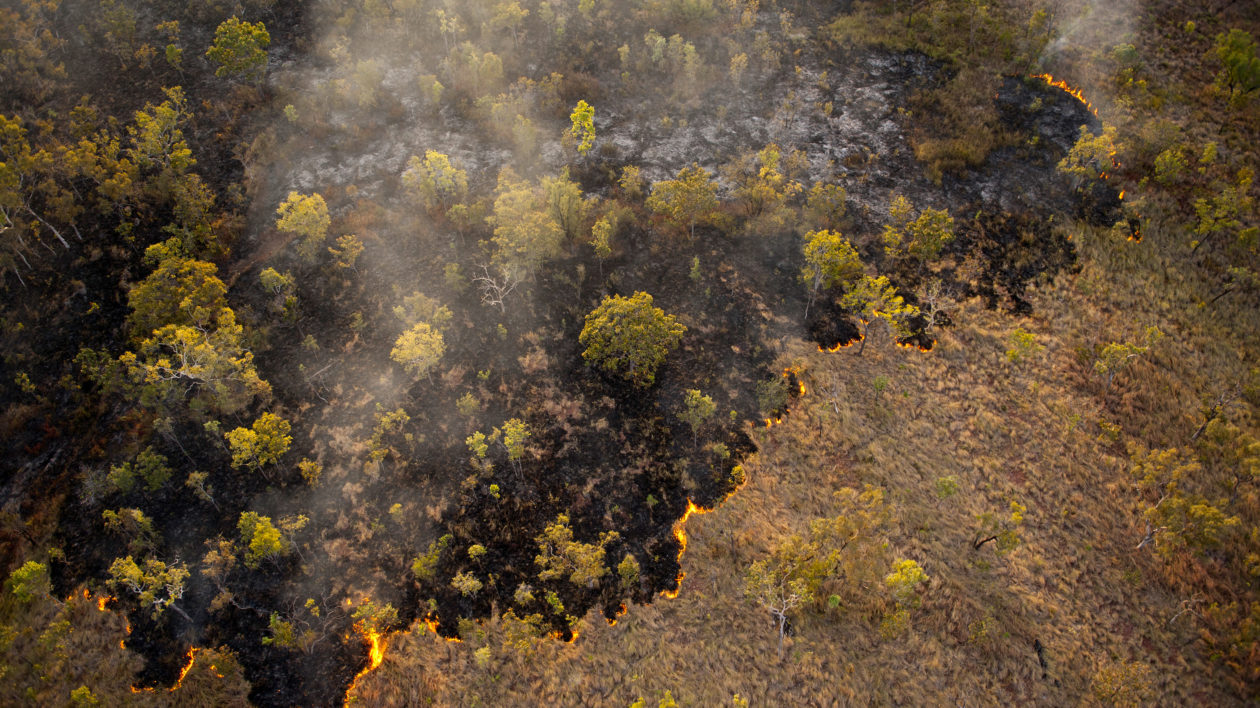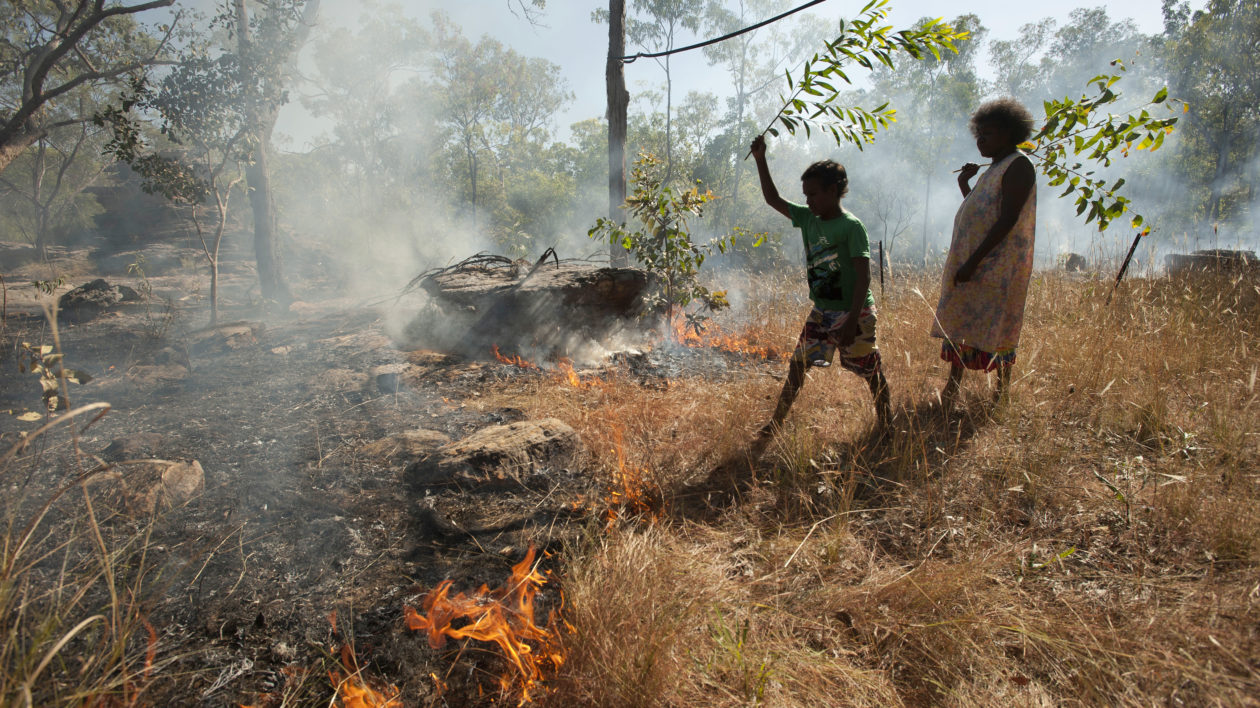News reports often focus on the destructive aspects of fire — threatening people and property when they escape human control.
But new research from The Nature Conservancy demonstrates that fire management in savannas has the potential to significantly reduce greenhouse gas emissions, helping developing nations meet their contributions toward the Paris Agreement.
Transforming savannas across Australia
Though the word savanna usually conjures up images of roaming giraffes and grazing zebras on the African Serengeti, these grasslands and woodlands cover 20 percent of the earth’s land surface and are found on every continent except Antarctica.
“Savannas are some of the most fire-prone landscapes in the world,” says Geoff Lipsett-Moore, a climate specialist at The Nature Conservancy. Savanna fires burn an area larger than India each year — about 3.3 million square kilometers — and account for 70 percent of fires worldwide. But how and when these landscapes burn makes a big difference to both the environment and to the people living within them.
Lipsett-Moore helped establish the Conservancy’s first savanna burning program at Fish River Station, in Northern Australia. There, the Conservancy worked with the Indigenous Land Corporation and Aboriginal landowners to reduce carbon emissions by implementing a fire-management plan that combines traditional knowledge and western science.
“When fires occur later in the dry season, the grasses are so much drier and the fire burns more intensely over greater area, and so releases more greenhouse gases,” says Nicholas Wolff, a climate scientist at the Conservancy.
By deliberately setting small, controlled burns early in the dry season, when it’s cooler and wetter, Fish River managers were able to reduce the fuel load and fire intensity, as well as prevent large-scale, late-season wildfires. After two years, the project sold the resulting 23,500 tonnes of emissions offsets to a global corporation under Australia’s regulatory carbon market, generating income for ongoing conservation work on country.
Six years later, savanna burning projects are underway across 32 million hectares of northern Australia, and a portion of those projects have secured contracts under the national carbon market to abate 13.8 million tonnes of CO2 equivalent over the next 7 to 10 years. These sales will generate an estimated $163 million AUD for indigenous landowners and pastoralists to manage their lands.

Global potential for savanna burning
Recognizing the potential of these methods beyond Australia, the research team set out to quantify where and to what extent similar fire management techniques could work across the world. They used precipitation data and satellite imagery of burned area to determine which countries have savannas with a significant amount of late dry season burns.
Then they calculated potential emissions reductions for both methane and nitrous oxide. “Those are both very severe greenhouse gases, much more so than carbon dioxide,” says Wolff. “With fire these gases are a net addition into the atmosphere, so anything you can do to control the intensity and amount of fire will cut back on those emissions.”
Their results, published in Nature Communications, show that 70 percent of emissions from global savanna fires occur in the late dry season, presenting significant opportunities for abatement. They identified 37 countries with significant late dry season emissions that could be greatly reduced through early-dry-season fire management. These nations include 29 countries in Africa, six in South America, and Australia and Papua New Guinea. Together, they produce 99.9 percent of total net emissions from all savanna fires, representing an abatement potential of 89.3 million tonnes of carbon dioxide equivalents per year.
“That’s the same as removing 19 million cars from the road each year,” says Wolff, “and that number will only increase if we include additional carbon sequestration in our estimates.”
As a final step, the scientists identified a subset of countries suitable for near-term development of savanna burning projects. They focused on countries with large protected area estates, where burning pilots could be implemented away from urban development, on land without complicating tenure rights. All 17 of these nations are in Africa and are classified as least-developed countries by the United Nations, which makes them eligible for funding for climate change adaptation and mitigation actions under the Green Climate Fund.
Despite being some of the lowest emissions-generating countries in the world, these nations are committed to reducing their emissions under the Paris Agreement. “But doing that in a country that is still developing is an incredible burden,” says Wolff, “so savanna burning could be an easy, inexpensive way for them to meet their climate obligations, generate revenue, and get other benefits, too.”
Capitalizing on these potential economic benefits would require a global carbon market, among other enabling conditions. But Wolff and Lipsett-Moore are hopeful that this can occur in the future, as nations move to meet their obligations under the Paris Agreement.

Transforming lives through fire
In Australia, the benefits of savanna burning go far beyond emissions abatement. “Aboriginal communities in the Northern Territory are some of the most vulnerable people in Australia,” says Lipsett-Moore. “They are country and culture rich, but cash poor.”
Indigenous Australians have used fire as a tool to nurture their land for millennia, and savanna burning projects harness this traditional knowledge to help reinstate cultural ties to country and generate employment opportunities and income for remote communities. Scientists are also discovering that traditional burning helps restore ecosystem health, improve biodiversity, and limit the harmful effects of invasive predators.
“If these processes can work in Australia, then maybe they can work in Angola or Zambia, the edge of the Congo or Ethiopia, Tanzania or Mozambique,” says Lipsett-Moore. “We’re seeing economic, social, biodiversity and climate benefits… where else in our conservation work do we get so many wins?”




Thanks for sharing this important information. I love that your organization embraces world wide partnerships and practical solutions that everyone can implement, either as individuals or in groups.
Thanks for sharing this important information. I love that your organization embraces partnerships and solutions that are very doable.
This will increase woody encroachment which is a huge problem across many savannas globallying.
Or increase sequestration and greatly offset emissions to the tune of 1.26 Gt CO2e (if you include all carbon pools). What is the trade-off? As it is savanna’s are being converted to agriculture. Do we continue on a trajectory beyond 2 degrees of warming with all its associated impacts, or do we mobilize all efforts to reduce global emissions? Or another way of looking at it – Do we watch our house burn down around us – while we are doing the dishes? Best GLM.